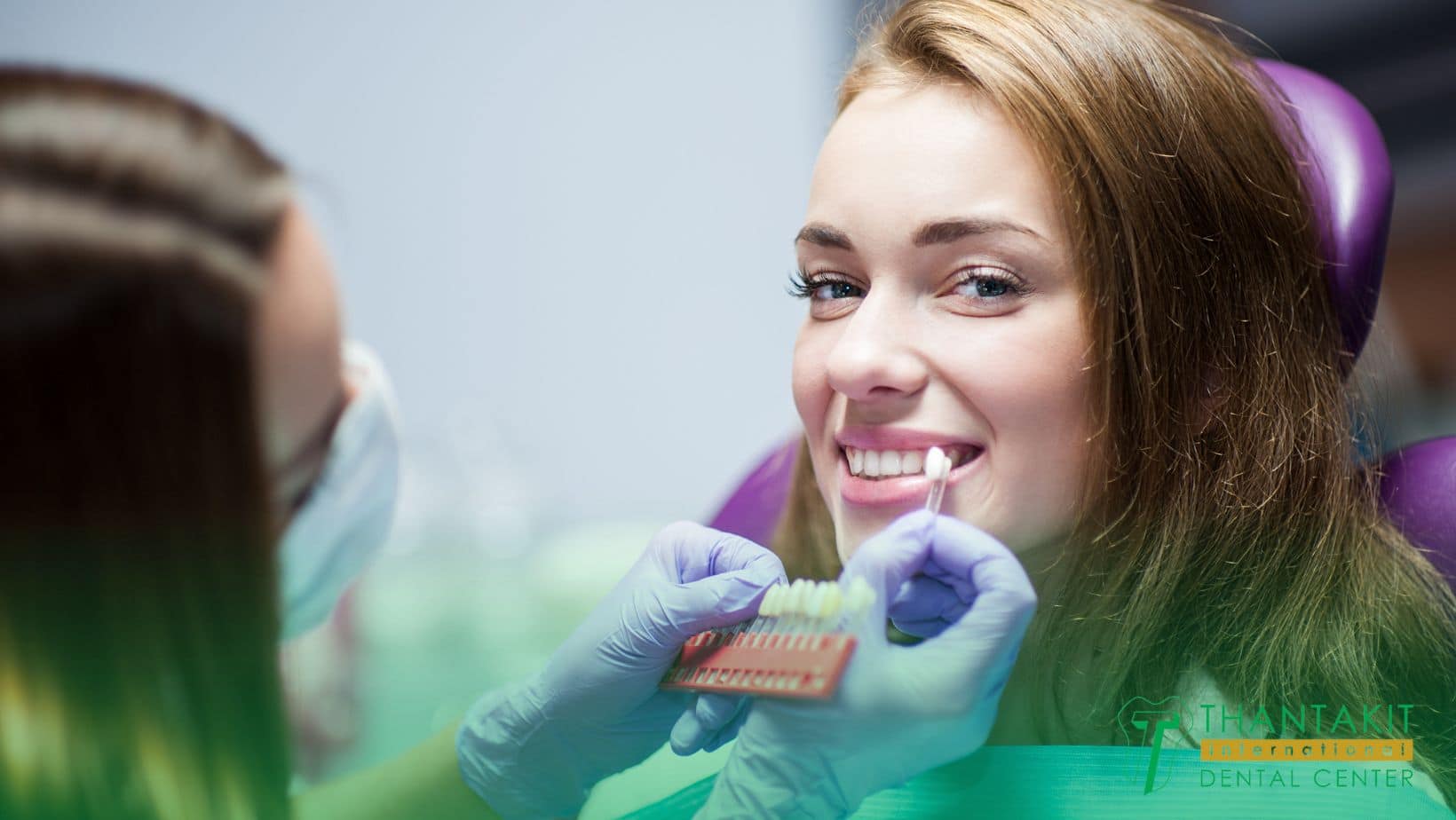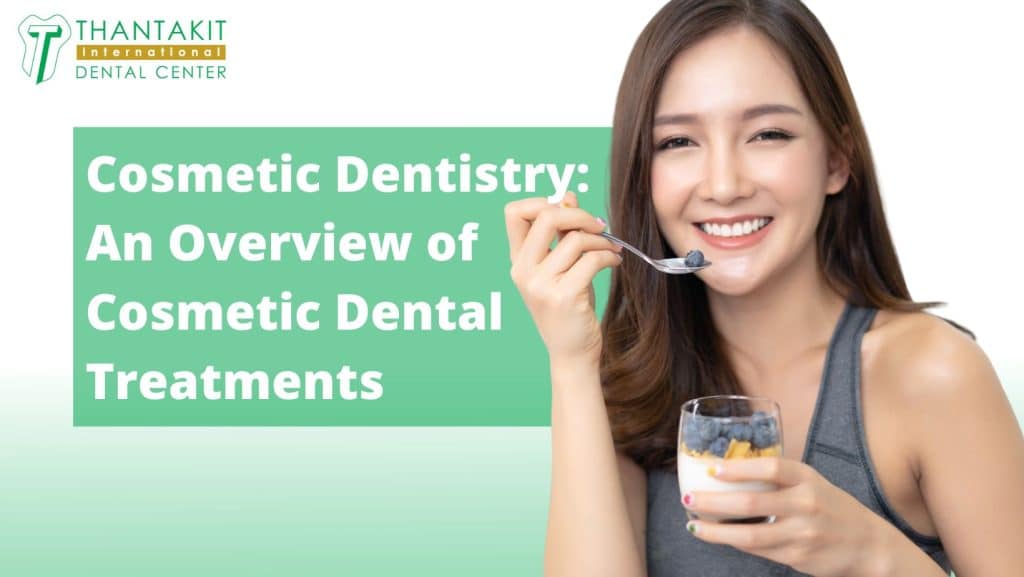Cosmetic Dentistry: An overview of cosmetic dental treatments such as teeth whitening, dental veneers, and dental implants, including the benefits and risks of each treatment.
Not every dental issue is foundational. Sure, healthy teeth also tend to look great when you have a complete set of them. However, sometimes the issue is more cosmetic.
You might have crooked teeth that function fine but can be improved looks-wise. Or you have yellowed teeth from staining that could use some teeth whitening. In that regard, cosmetic dentistry is here to the rescue!
Page Contents
What is Cosmetic Dentistry?
Cosmetic dentistry is when you fix the aesthetics of your teeth to ensure that they don’t only function superbly but look as healthy as they work. It’s all about creating more pleasing smiles with symmetry and balance in mind.
If you want cheaper rates for common cosmetic dental procedures such as teeth whitening, dental veneers, dental implants, and dental bonding, look into Thailand dental tourism.
Dental tourism combines vacations with dental services so affordable you’ll save money even if you take the travel costs into consideration!

What’s the Difference Between General and Cosmetic Dentistry?
Cosmetic dentistry covers the “looks” of your teeth while general dentistry deals with their overall health. Insurance-wise, you’re more likely to get coverage for general dentistry over cosmetic dentistry every time.
The general practitioner dentist serves as your primary provider of dental healthcare who’ll offer you restorative dentistry treatments (such as bridges, crowns, and fillings) and preventative care (such as teeth cleanings and oral hygiene advice).
Some restorative treatments like crowns and bridges can be both general and cosmetic dentistry treatments since they restore both dental look and function.
However, some cosmetic dental treatments are purely for aesthetic purposes, such as teeth whitening, gum or dental contouring, and so forth.
Who Should Avail of Cosmetic Dentistry?
If you have the following issues, you could solve them with the assistance of a cosmetic dentist. Some of them can even be covered by the general dentist practitioner as well.
-
Misshapen teeth
-
Misaligned teeth
-
Chipped or cracked teeth
-
Tooth staining or discoloration
-
Gap tooth or huge spaces between teeth (diastema)
You can get cosmetic dental treatments as long as you have healthy teeth and gums. In other words, resolve any dental health issues first before making any cosmetic improvements to your teeth.
Dental Bonding 101
To fix enamel cracks or reshape misshapen teeth, dental bonding uses tooth-colored composite resin just like with teeth filling.
The cosmetic dentist uses the resin to cover up various aesthetic issues such as discoloration, hairline cracks or craze lines, and other issues. The material covers up cracks and gaps like dental cement.
It’s the “plaster” capable of hiding imperfections or changing tooth shape altogether so that you’d have the uniform smile of a celebrity!
Here are the key things to know about dental bonding.
-
Known for Its Durability: Dental bonding resin is so durable and flexible that it could alter your bite altogether by changing the shape of individual teeth. The material could make it wider, longer, more uniform, and so forth.
-
Completely Reversible: Some patients prefer dental bonding over other more permanent cosmetic treatments because it’s completely reversible and doesn’t require the enamel alteration of the original tooth.
-
Requires Replacement: Dental bonding material requires replacement every 5-7 years though. On the bright side, you won’t have to remove the natural tooth enamel or cover it up with a crown, which normally necessitates shaving off part of the tooth to make it fit inside the restoration.

Teeth Whitening 101
When patients think of cosmetic dentistry, the first thing that comes to their mind is teeth whitening or bleaching. Your options for teeth whitening include simple ones like whitening toothpaste to professional teeth bleaching sessions with your dentist.
Some whitening services claim to remove your teeth’s extrinsic stains. Meanwhile, other products go for both intrinsic and extrinsic bleaching to lighten their color from the inside out.
The different types of teeth whitening are as follows.
-
In-Office Teeth Whitening: When whitening your teeth at the dentist’s office, they’re subjected to higher dosages of active bleaching ingredients to achieve visible whitening results at a quicker pace.
According to a 2014 study, in-office dental whitening may require several sessions to achieve the whiteness you desire. They can be quite expensive to deal with out-of-pocket, and most insurance premiums don’t include cosmetic coverage.
You can get special discounts depending on the center or clinic you’re patronizing. You can also avail yourself of dental tourism packages to get affordable whitening at a fraction of the cost.
An ultraviolet light can also be shone on your teeth to activate the bleaching agent and whiten your teeth the same way leaving bleached clothes under the hot sun results in them getting as white as possible.
-
OTC Whitening Products: There are over-the-counter teeth whitening products you can avail yourself of like dental whitening mouthwash (please don’t swallow it) and teeth whitening toothpaste with enamel-bleaching ingredients.
Many of these products contain baking soda or even abrasive charcoal to scrub and absorb the stains on your teeth right away, especially if you’re a tobacco smoker or regular tea/coffee drinker.
OTC whitening product formulas can even contain low concentrations of hydrogen peroxide and carbamide (the ingredients used for in-office dental whitening).
-
Home Whitening Products: You can also avail yourself of dentist-approved whitening kits for use at home to whiten your teeth significantly like with an in-office procedure. They typically come in a paste or gel form as well as sticky strips.
There are whitening kits out there that soak your teeth with the bleaching agent with the assistance of a mouth guard over them.
The mouth guard keeps the agent onto the enamel, like when you soak your white clothes in water and bleach inside a bucket. It increases the absorption limit and amount of whitening agent that can come into contact with your teeth.
UV lights can also be included in home kits to replicate in-office dental bleaching. Please follow the bleaching instructions carefully so that you don’t overdo the whitening and end up with side effects like thinner enamel or sensitive teeth.
As a side note, some of the most affordable in-office teeth whitening sessions are available to you through dental tourism in Thailand. It’s a wellness vacation that gives you the best of both worlds in terms of entertainment and cosmetic dentistry.
Specifically, you can get Philips ZOOM! Whitespeed Tooth Whitening for ฿12,000 ($335) or a special promo of ฿10,000 ($280) for 4 cycles in one session. In contrast, the average cost for teeth whitening in the U.S. ranges from $650 to $750 per session.

Dental Veneers 101
Unlike crowns, dental veneers fit over the front surface of your teeth instead of covering their entirety like a cap. You can use them to conceal stains, chips, and cracks as well as a myriad of other imperfections.
They’re more cosmetic than functional compared to crowns that can even restore or change your bite since they only cover the front part of the teeth and they’re mostly used on front-facing teeth.
-
How Do Veneers Work? Veneers camouflage cosmetic flaws by covering the front surface of your front teeth with what looks like more teeth material or enamel shells that seamlessly fit on them.
-
Types of Veneers: You have many different types of veneers to choose from depending on how severe your issue is. They differ in terms of the material they’re made of and how much of the original teeth is left for them to attach to.
-
Composite Veneers: If you have mild cosmetic issues, composite veneers are enough to handle them. The material is used like a thin layer of enamel-like cement.
These veneers are also made from the same tooth-colored composite resin used for teeth filling and dental bonding. They can be molded like concrete and hardened like enamel shells.
-
Porcelain Veneers: If you wish to address a multitude of aesthetic issues with a hard foundational shell cover, the porcelain veneer might be your best bet. They’re custom-fitted to the mold of your teeth.
Before the porcelain veneer shells are placed on your natural teeth, the teeth must be prepped by outright removing enamel from them, like in the case of bridges and crowns. This roughens the teeth’s surface so your veneers can attach to something.
-
No-Prep Veneers: No preparation or minimal preparation veneers are just as their names suggest—you can put them onto your original front teeth without invasively prepping their surface or roughing them up.
These veneers are also custom fitted to your teeth and smile like in the case of traditional porcelain veneers. However, they require less removal of enamel for them to stick or bond to the surface of your teeth.
Take note that less removal doesn’t mean there’s no enamel removal at all. Some enamel will still be removed to allow for the veneers to work.
-
Removable Veneers: Removable veneers are also known as snap-on or pop-on veneers. Ostensibly, you can remove and put them back by popping or snapping them onto the surface of your teeth to hide their imperfections.
Like retainers, they can make it difficult to eat or give you a speech impediment due to their removable nature, as opposed to customized “permanent” veneers.
You can also avail of super affordable veneers at Thantakit Center in Thailand. They offer composite veneers for ฿6,000 ($170) per tooth and full ceramic/porcelain e.Max veneers or zirconia veneers for ฿18,000 ($500).
As for porcelain e.Max or zirconia veneers with Digital Smile Design (DSD), they cost ฿22,000 ($615) per tooth. You can get them for only ฿20,000 ($560) per tooth if you choose to do 8 teeth at the same time.
In contrast, in the U.S., composite veneers cost between $800 and $950 per tooth. Meanwhile, porcelain veneers cost around $1,000 to $3,000.

Dental Implants 101
Dental implant surgery replicates how natural teeth are anchored to your gums and jaw by their roots right into their tooth sockets. It involves surgically replacing the missing tooth roots with metal screw posts.
From there, you can place a crown or a bridge over the implant to fill in the space of any number of missing teeth you wish to replace. Implants make your dental restoration work and feel like natural teeth compared to removable dentures or even bridges.
-
Is It Cosmetic or Functional? Dental implants are cosmetic because they help complete your smile by serving as the artificial root for a single crown or a whole set of crowns forming a bridge. They’re also fully functional because they make crowns feel and work like natural teeth.
-
Should You Get an Implant or Not? Many seniors opt out of getting an implant in favor of removable dentures because it’s still a major type of surgery that requires significant recovery time. Therefore, they might be right for you if you tick all the following checklist items:
-
You have one or more missing teeth.
-
You wish to fix a speech impediment.
-
Your oral tissues are perfectly healthy.
-
You’re not suffering from gingivitis or periodontitis.
-
You’re willing to commit to months of waiting and healing.
-
You don’t want to wear dentures or you’re unable to do so.
-
You don’t smoke tobacco products like cigarettes and chewable tobacco.
-
You’re not suffering from a cardiovascular, circulatory, or hemorrhaging ailment.
-
You don’t have any diseases or conditions that affect the healing of your bones.
-
Either of your jawbones has reached full growth and is thick enough to house an implant.
-
You have adequate bone mass to secure the implant, or you can recover from bone graft surgery.
-
Alternative to Bridgework or Crown Restorations: Dental implants help keep your remaining natural teeth from being used as posts or foundations for dental bridgework or crowns. A tooth or teeth need not be prepped or shaved down to fit inside a crown or bridge.
-
Works for Patients That Lost All Their Teeth: If you’re a viable candidate for multiple dental implants, you can put in all-on-6 or all-on-8 implants on both the upper and lower jaw to serve as foundations for multiple bridgework sections. This will give you a complete smile without resorting to dentures.
-
A Worthwhile Dentistry Invention: Before dental implants came about, the only way you could fix missing teeth was by dentures or dental bridges. The dental implant is arguably a functional and foundational dentistry procedure on top of being a cosmetic one.
Dental implants are really expensive and aren’t usually covered by your insurance provider unless you avail yourself of a more expensive premium for them. This means you’ll most likely have to pay for it out-of-pocket.
You can save money on them by availing a dental tour in Thailand. A single Dentium implant at Thantakit costs ฿65,000 ($1,820). As for Cortex implants, they’re ฿75,000 ($2,100). Straumann implants cost ฿85,000 ($2,380). All of these options already include the zirconia crown for good measure.
Meanwhile, on average, the costs of single implant surgery in the U.S.—which includes the crown, abutment, the surgery itself, and pre-op to post-op care—can go all the way from $3,000 to $4,800 depending on what brand of implant you’ve availed of.
Summary
If you’re self-conscious about your smile because of yellowed teeth, crooked grin, or cracked and chipped enamel, you can do something about it with the assistance of cosmetic dentistry’s teeth whitening and veneer-camouflaging treatments.
Just make sure your teeth are free of cavities and you don’t have gum disease. Otherwise, resolve those issues first. Cosmetic dentistry doesn’t come cheap though and it’s not covered by insurance. One way to avail of it affordably is by Thailand dental tourism.
Thantakit International Dental Center is Thailand’s longest established dental center. Situated in Bangkok, our clinic is renowned across the world as a destination for world-class dentistry, with most of our patients flying to us from Australia.
Please contact us today and get a FREE dental consultation.












